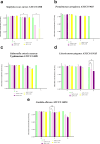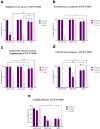Green synthesis of silver nanoparticles (AgNPs) from G. stearothermophilus GF16: stable and versatile nanomaterials with antioxidant, antimicrobial, and catalytic properties
- PMID: 40830875
- PMCID: PMC12362984
- DOI: 10.1186/s12934-025-02815-9
Green synthesis of silver nanoparticles (AgNPs) from G. stearothermophilus GF16: stable and versatile nanomaterials with antioxidant, antimicrobial, and catalytic properties
Abstract
Background: Silver nanoparticles (AgNPs) have attracted considerable interest for their distinctive physicochemical properties and wide-ranging applications in nanomedicine, environmental catalysis, and antimicrobial applications. However, sustainable and robust biosynthesis methods remain a challenge.
Results: In this study, we report the biosynthesis of thermostable AgNPs using the secretome of Geobacillus stearothermophilus GF16, a thermophilic and metal-resistant bacterium isolated from the hydrothermal volcanic area of Pisciarelli, Italy. The synthesis was performed without specialized growth media, relying solely on the cell-free bacterial supernatant, and was systematically optimized by varying precursor concentration, temperature, pH, and reaction time. The nanoparticles were characterized by UV-Vis spectroscopy, dynamic light scattering, Fourier-transform infrared spectroscopy, scanning (SEM) and transmission (TEM) electron microscopy. Morphological analysis showed predominantly subspherical nanoparticles with average diameters of 17 ± 5 nm (SEM) and 16 ± 5-7 nm (TEM), depending on precursor concentration. Thermogravimetric analysis demonstrated excellent thermal stability with retention of structural integrity up to 120 °C, an exceptional feature among biogenic AgNPs. The obtained AgNPs exhibited remarkable radical scavenging activity, reaching up to 79% in DPPH and 75% in ABTS assays at 100 µg/mL, highlighting a level of antioxidant performance rarely observed in AgNPs of bacterial origin. In addition to their redox properties, the nanoparticles demonstrated efficient catalytic activity as evidenced by the complete degradation of Congo Red in 20 min and 4-nitrophenol in 35 min. Time-kill assays and minimum inhibitory concentration (MIC) also showed a broad-spectrum antimicrobial potential with complete inhibition of Staphylococcus aureus, Pseudomonas aeruginosa, and Salmonella Typhimurium at 100 µg/mL. Interestingly, MIC values were significantly lower than those reported for comparable AgNPs. Notably, the nanoparticles also displayed hemocompatibility, validated by hemolysis assays performed on both healthy and β-thalassemic erythrocytes, with hemolysis rates consistently below the 2% safety threshold.
Conclusions: Overall, this study presents the first comprehensive characterization of AgNPs biosynthesized by a thermophilic bacterium, highlighting their multifunctional potential. The use of a thermophilic bacterium as a robust and flexible microbial nanofactory offers a novel eco-friendly and scalable strategy for AgNP production. The resulting nanoparticles exhibit unique thermal stability, broad-spectrum bioactivity, and clinically relevant hemocompatibility, underscoring their promising applicability in nanomedicine, green catalysis, and environmental remediation.
Keywords: Antimicrobial activity; Biocompatibility; Catalytic efficiency; Extremophiles; Nanofactory; Silver nanoparticles.
© 2025. The Author(s).
Conflict of interest statement
Declarations. Consent for publication: Not applicable. Competing interests: The authors declare no competing interests.
Figures













Similar articles
-
Green synthesis of silver nanoparticles using Magnolia alba leaf extracts and evaluating their antimicrobial, anticancer, antioxidant, and photocatalytic properties.Sci Rep. 2025 Jul 3;15(1):23709. doi: 10.1038/s41598-025-08468-3. Sci Rep. 2025. PMID: 40610522 Free PMC article.
-
Biosynthesis and characterization of silver nanoparticles from Asplenium dalhousiae and their potential biological properties.PLoS One. 2025 Jun 30;20(6):e0325533. doi: 10.1371/journal.pone.0325533. eCollection 2025. PLoS One. 2025. PMID: 40587502 Free PMC article.
-
Characterization of Silver Nanoparticles Synthesized Using Hypericum perforatum L. and Their Effects on Staphylococcus aureus.Microsc Res Tech. 2025 Aug;88(8):2321-2332. doi: 10.1002/jemt.24862. Epub 2025 Mar 23. Microsc Res Tech. 2025. PMID: 40121669 Free PMC article.
-
Green Synthesis of Titanium Dioxide Nanoparticles: Physicochemical Characterization and Applications: A Review.Int J Mol Sci. 2025 Jun 6;26(12):5454. doi: 10.3390/ijms26125454. Int J Mol Sci. 2025. PMID: 40564917 Free PMC article. Review.
-
Lignin micro-nanospheres loaded with silver nanoparticles for excellent antibacterial activity.Int J Biol Macromol. 2025 Aug;319(Pt 2):145374. doi: 10.1016/j.ijbiomac.2025.145374. Epub 2025 Jun 19. Int J Biol Macromol. 2025. PMID: 40543783 Review.
References
-
- Guilger-Casagrande M, Germano-Costa T, Bilesky-José N, Pasquoto-Stigliani T, Carvalho L, Fraceto LF, et al. Influence of the capping of biogenic silver nanoparticles on their toxicity and mechanism of action towards sclerotinia sclerotiorum. J Nanobiotechnol 24 Febbraio. 2021;19(1):53. - PMC - PubMed
-
- Nyandoro VO, Masioge HK, Malago ZL. Biogenic synthesis of metal nanoparticles: promoting green nanotechnology and sustainable development goals. Clean Techn Environ Policy. 2024. 10.1007/s10098-024-02966-0. https://link.springer.com/. Accessed 12 Nov 2024.
-
- Di Fraia S, Di Meglio A, Massarotti N, Vanoli L, Bentivoglio R, Volpecina V. Energy recovery and waste valorization in a frozen food processing facility: a case study from lazio, Italy. Energy Effi Marzo. 2024;17(3):13.
-
- Puri A, Mohite P, Maitra S, Subramaniyan V, Kumarasamy V, Uti DE, et al. From nature to nanotechnology: the interplay of traditional medicine, green chemistry, and biogenic metallic phytonanoparticles in modern healthcare innovation and sustainability. Biomed Pharmacotherapy Gennaio. 2024;170:116083. - PubMed
MeSH terms
Substances
Grants and funding
LinkOut - more resources
Full Text Sources
Medical

